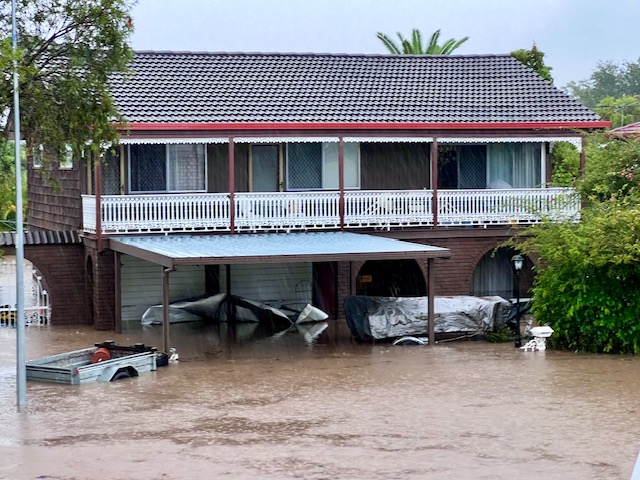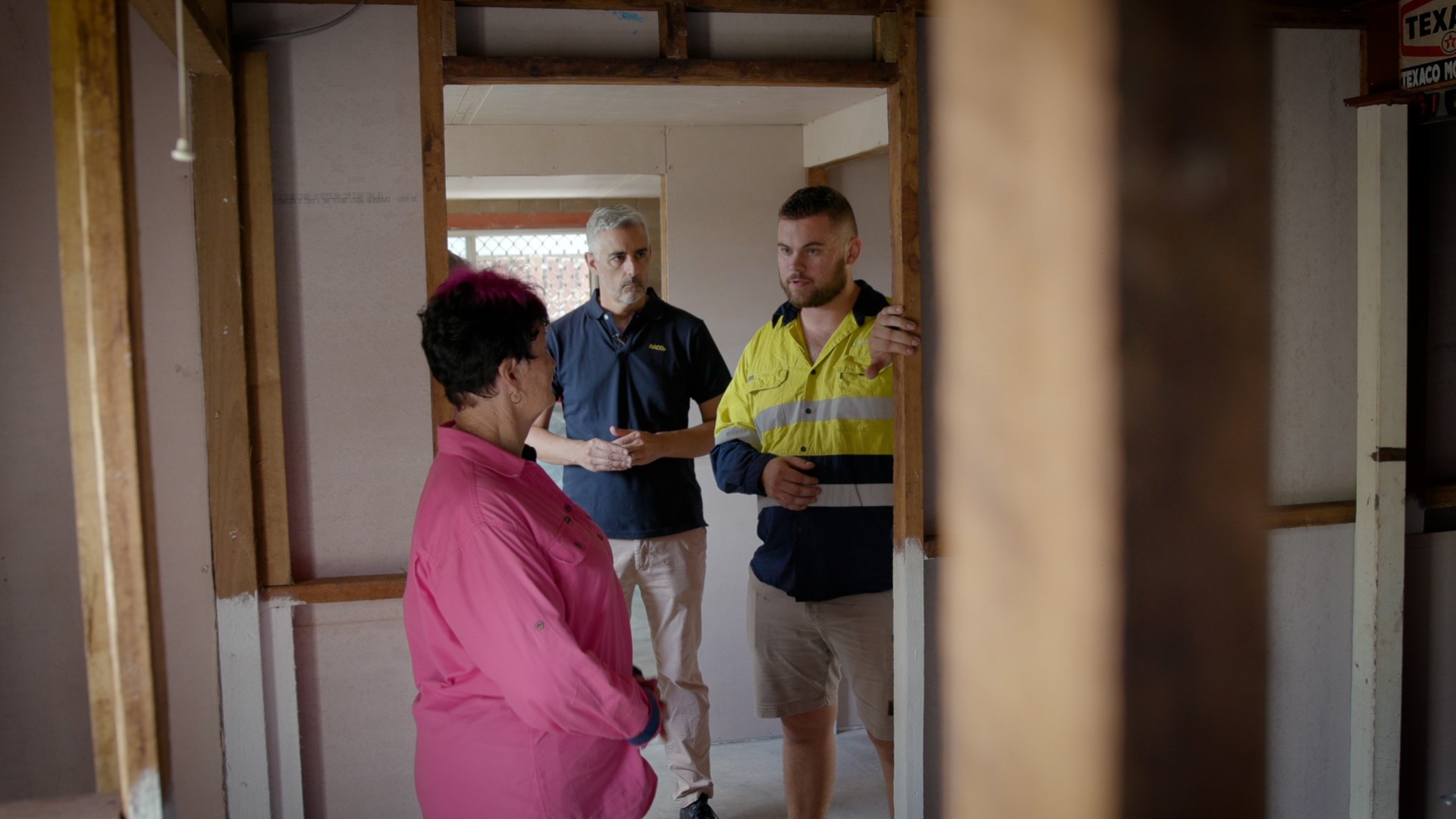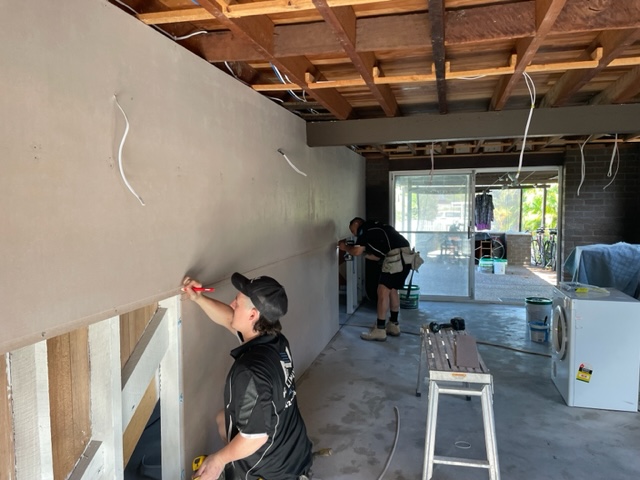Tips to make your home more weather-resilient
Follow this building advice to lessen the impact on your home and family from any future flooding event.

According to RACQ Insurance’s latest consumer survey, one in three Queenslanders are planning to spruce up their home in 2023.
However, less than half of those people are considering incorporating upgrades that will make their property more resilient to weather events, despite Queensland being the most disaster-prone state in the country.
Flood-resilient upgrades can help homeowners safely remove and store belongings before a flood as well as easily clean-up and quickly resume normal life after the water recedes – minimising long-term disruption.
In most instances, there is little to no extra cost for replacing standard materials with resilient materials.
RACQ panel builder Crispin Irvine, from Patterson’s Build Group, said there were a few simple ways homeowners could incorporate resilience upgrades.
“When we talk about flood resilience, many of us automatically think that involves raising the home and using unsightly materials, but that doesn’t have to be the case,” Mr Irvine said.
“Flood resilience doesn’t mean that water won’t enter the property. It encourages us to look at different designs and use materials that don’t absorb water, making it easier to dry and clean the property and get our members back home quicker.
“Simple changes like raising switchboards, power outlets and air-conditioning units prevents water from damaging critical electrical components necessary to live in the home, while opting for floating cabinetry or storage space can increase your home’s flood resilience.
“You might consider using building materials that can withstand water. For example, extending waterproofing, using fibre cement sheets for walling instead of plasterboard, having tiles with waterproof grout or polished concrete flooring and using solid timber doors, frames and skirting that won’t swell.”
 Flood resilient upgrades taking place at the Kriesch home.
Flood resilient upgrades taking place at the Kriesch home.
Brisbane residents and RACQ members Elizabeth and Kevin Kriesch have been upgrading their home following last year’s devastating February floods through their insurance claim as part of the State and Federal Governments’ Resilient Homes Fund program.
Ms Kriesch said they were passionate about future-proofing their home for future generations.
“We’ve lived in our north Brisbane home for 50 years and it’s never flooded before, so to see a metre of water through our ground floor was really distressing,” Ms Kriesch said.
“We want this home to hold its value and be an asset for our children and grandchildren for years to come, and to ensure that happens we are upgrading the materials and building design of the lower level so it can better withstand future weather events.
“Hopefully we won’t have another flood, but if we do, the recovery will be much easier and quicker because the home is much more resilient.”

Flood resilient upgrades taking place at the Kriesch home.
Permanently upgrading your home’s design and materials to be more resilient isn’t the only way to reduce damage caused during an extreme weather event.
RACQ Chief Executive Insurance Trent Sayers said making sure your home maintenance was up to scratch was also crucial.
“Getting your home and garden in good shape will not only improve your chances of withstanding severe weather events, but it can also help to reduce the likelihood of maintenance-related issues causing delays in the insurance claim process, if the worse was to happen,” Mr Sayers said.
“Maintenance work can include, but is not limited to, clearing your property and gutters of debris and checking your downpipes, roof, gutters and wet areas for any damage or leaks.
“It’s also important to check your home insurance policy is up-to-date and suits your needs.”
Top tips for resilient home upgrades
- Raise air-conditioner units, switchboards, hot water units, storage shelves, power points, washing machines and kitchen appliances, and cabinetry like a wall-hung bathroom vanity.
- Upgrade to flood-resilient flooring and skirting.
- Where possible, replace cavity walls with non-cavity walls to reduce the chance of mould.
- Use flood-resilient wall framing.
- Replace wall linings with flood-resilient wall linings.
- Replace hollow-core doors with solid doors.
- Replace cavity sliding doors with swing or face-of-wall sliding doors.
- Install flood-proof cabinetry.
- Install corrosion-resilient door and window handles.
As part of the Resilient Homes Fund program, the Government has released a guidebook for homeowners with advice on how to make resilient upgrades to their properties.
RACQ recommends talking to a licensed builder or architect about what measures could be incorporated into your home.
Always refer to the manufacturer’s product specifications of all materials and products to ensure they are water resistant or waterproof and fit for purpose before installing.
Learn about RACQ Home and Contents Insurance
The information in this article has been prepared for general information purposes only and is not intended as legal advice or specific advice to any particular person. Any advice contained in the document is general advice, not intended as legal advice or professional advice and does not take into account any person’s particular circumstances. Before acting on anything based on this advice you should consider its appropriateness to you, having regard to your objectives and needs.
Related topics
Things to note
The information in this article has been prepared for general information purposes only and is not intended as legal advice or specific advice to any particular person. Any advice contained in the document is general advice, not intended as legal advice or professional advice and does not take into account any person’s particular circumstances. Before acting on anything based on this advice you should consider its appropriateness to you, having regard to your objectives and needs.
Insurance Products (excluding Travel Insurance) are issued by RACQ Insurance Limited ABN 50 009 704 152 (RACQI) and arranged by its agent, RACQ Distribution Services Pty Ltd (RDS) ABN 35 116 361 650, AFSL 567130 and RDS' authorised representatives (including RACQ Operations Pty Ltd ABN 80 009 663 414, AR No. 234978 (RACQO). Conditions, limits and exclusions apply. RDS and RACQO are in the RACQ group of companies. One of the companies in the RACQ group of companies has a minority shareholding in RACQI.
RDS and RACQO have not taken your personal objectives, circumstances or needs into account when preparing advice regarding insurance products and you will need to consider whether the advice is appropriate for you. Read the Product Disclosure Statement (PDS) and any applicable Supplementary PDS before making a purchase decision on this product. You can also access our Target Market Determinations on this website. RDS receives a commission from RACQI for the policies it arranges. RACQO receives fees paid for services it provides to RDS. Further details about remuneration are available on request prior to purchasing.
Banking and loan products issued by Members Banking Group Limited ABN 83 087 651 054 AFSL/Australian credit licence 241195 trading as RACQ Bank. Terms, conditions, fees, charges and lending policies apply. This is general advice only and may not be right for you. This information does not take your personal objectives, circumstances or needs into account. Read the disclosure documents for your selected product or service, including the Financial Services Guide and the Terms and Conditions, and consider if appropriate for you before deciding.
Except for RACQ Bank, any RACQ entity referred to on this page is not an authorised deposit-taking institution for the purposes of the Banking Act 1959 (Cth). That entity’s obligations do not represent deposits or other liabilities of RACQ Bank. RACQ Bank does not guarantee or otherwise provide assurance in respect of the obligations of that entity, unless noted otherwise.
RACQ Bank subscribes to the Customer Owned Banking Code of Practice which establishes higher standards than the law requires. The Code reflects modern consumer expectations and developments in approaches to issues such as consumer vulnerability, guarantors, and supporting customers through financial hardship. Please read our Customer Owned Banking Code of Practice page for more information.
RACQ Operations Pty Ltd (ABN 80 009 663 414 AR 000234978) and Members Travel Group Pty Ltd (ABN 45 144 538 803 AR 000432492) are acting as an Authorised Representative of the issuer of the insurance, Tokio Marine & Nichido Fire Insurance Co., Ltd. (ABN 80 000 438 291 AFSL 246 548). Any advice set out above is general in nature only, and does not take into account your objectives, financial situation or needs. Before purchasing any travel products, please consider the RACQ Travel Insurance Product Disclosure Statement (PDS) and the Target Market Determinations (TMDs) that apply to these products. Whilst the PDS outlines the Terms and Conditions of these products, the TMDs outline the intended class of customers that comprise the target market for these travel products. This will allow you to consider which products best suit your objectives, financial situation and needs and consider the products appropriateness to your personal circumstances. TMDs also outline matters involving the distribution and the review of these products. The PDS, Supplementary PDS and TMDs for each travel product can be found here.


